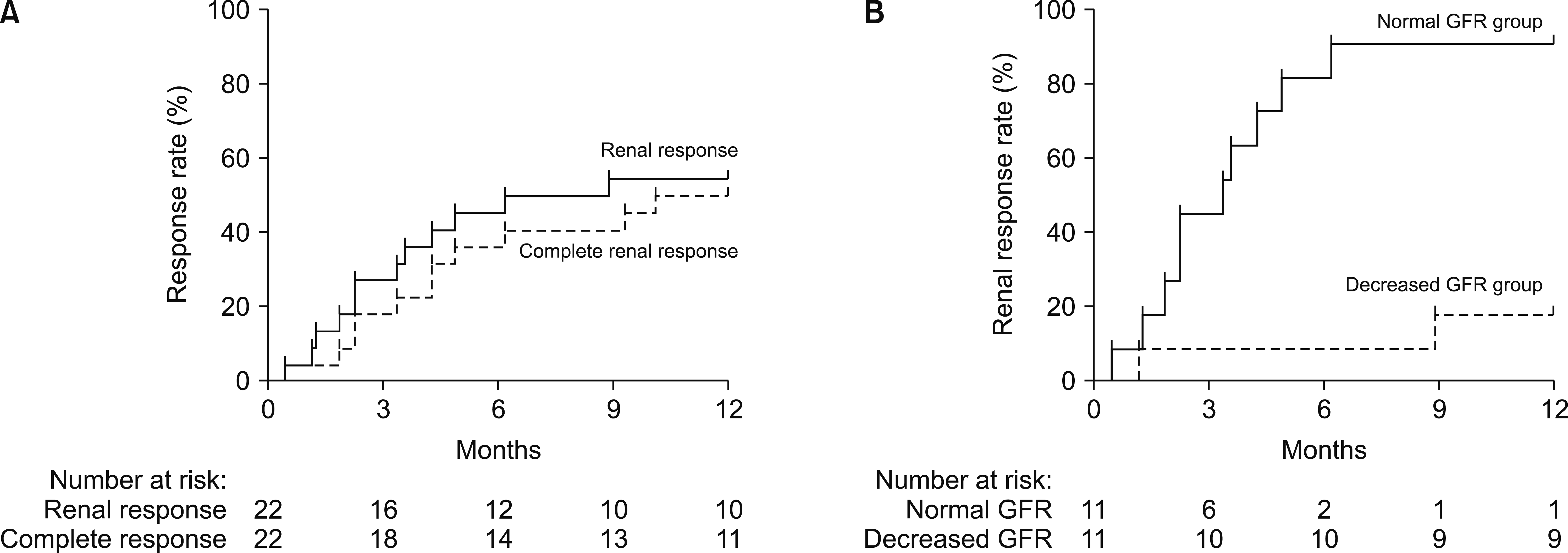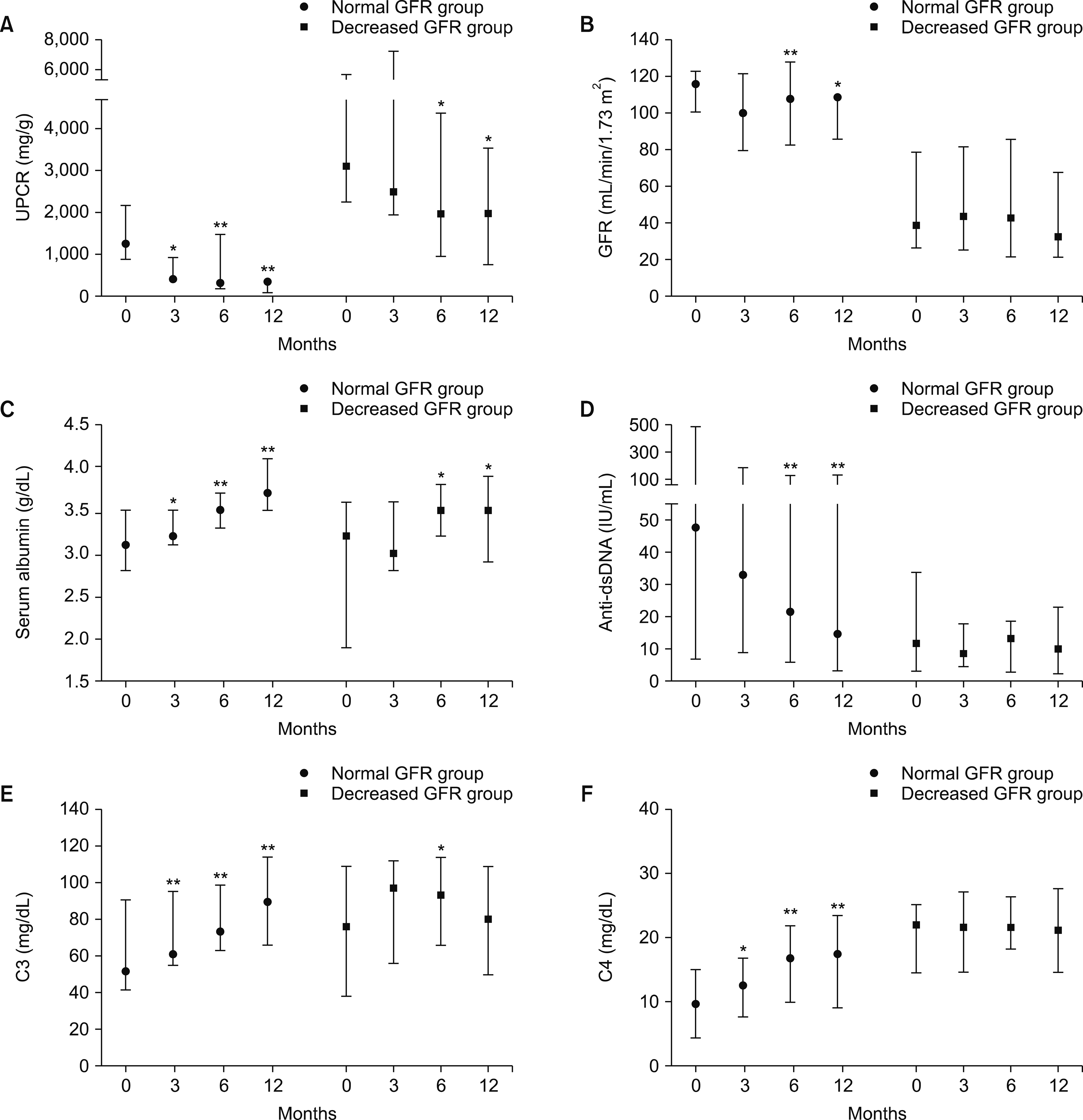1. Ginzler EM, Dooley MA, Aranow C, Kim MY, Buyon J, Merrill JT, et al. 2005; Mycophenolate mofetil or intravenous cyclophosphamide for lupus nephritis. N Engl J Med. 353:2219–28. DOI:
10.1056/NEJMoa043731. PMID:
16306519.

2. Houssiau FA, Vasconcelos C, D'Cruz D, Sebastiani GD, Garrido Ed Ede R, Danieli MG, et al. 2002; Immunosuppressive therapy in lupus nephritis: the Euro-Lupus Nephritis Trial, a randomized trial of low-dose versus high-dose intravenous cyclophosphamide. Arthritis Rheum. 46:2121–31. DOI:
10.1002/art.10461. PMID:
12209517.

3. Ramos L, Isenberg D. 2015; Rituximab: the lupus journey. Curr Treatm Opt Rheumatol. 1:30–41. DOI:
10.1007/s40674-014-0003-2.

4. Smolen JS, Landewé RBM, Bijlsma JWJ, Burmester GR, Dougados M, Kerschbaumer A, et al. 2020; EULAR recommendations for the management of rheumatoid arthritis with synthetic and biological disease-modifying antirheumatic drugs: 2019 update. Ann Rheum Dis. 79:685–99. DOI:
10.1136/annrheumdis-2019-216655. PMID:
31969328.
5. Stone JH, Merkel PA, Spiera R, Seo P, Langford CA, Hoffman GS, et al. 2010; Rituximab versus cyclophosphamide for ANCA-associated vasculitis. N Engl J Med. 363:221–32. DOI:
10.1056/NEJMoa0909905. PMID:
20647199. PMCID:
PMC3137658.

6. Rovin BH, Furie R, Latinis K, Looney RJ, Fervenza FC, Sanchez-Guerrero J, et al. 2012; Efficacy and safety of rituximab in patients with active proliferative lupus nephritis: the Lupus Nephritis Assessment with Rituximab study. Arthritis Rheum. 64:1215–26. DOI:
10.1002/art.34359. PMID:
22231479.

7. Weidenbusch M, Römmele C, Schröttle A, Anders HJ. 2013; Beyond the LUNAR trial. Efficacy of rituximab in refractory lupus nephritis. Nephrol Dial Transplant. 28:106–11. DOI:
10.1093/ndt/gfs285. PMID:
22764193.

8. Moroni G, Raffiotta F, Trezzi B, Giglio E, Mezzina N, Del Papa N, et al. 2014; Rituximab vs mycophenolate and vs cyclophosphamide pulses for induction therapy of active lupus nephritis: a clinical observational study. Rheumatology (Oxford). 53:1570–7. DOI:
10.1093/rheumatology/ket462. PMID:
24505125.

9. Shin JS, Kim KN. 2019; Catastrophic antiphospholipid syndrome associated with systemic lupus erythematosus successfully treated with rituximab: a case report. J Rheum Dis. 26:74–8. DOI:
10.4078/jrd.2019.26.1.74.

10. Austin HA 3rd, Boumpas DT, Vaughan EM, Balow JE. 1994; Predicting renal outcomes in severe lupus nephritis: contributions of clinical and histologic data. Kidney Int. 45:544–50. DOI:
10.1038/ki.1994.70. PMID:
8164443.

11. Liu G, Wang H, Le J, Lan L, Xu Y, Yang Y, et al. 2019; Early-stage predictors for treatment responses in patients with active lupus nephritis. Lupus. 28:283–9. DOI:
10.1177/0961203319826703. PMID:
30682900.

12. Weening JJ, D'Agati VD, Schwartz MM, Seshan SV, Alpers CE, Appel GB, et al. 2004; The classification of glomerulonephritis in systemic lupus erythematosus revisited. J Am Soc Nephrol. 15:241–50. DOI:
10.1097/01.ASN.0000108969.21691.5D. PMID:
14747370.

13. Bertsias GK, Tektonidou M, Amoura Z, Aringer M, Bajema I, Berden JH, et al. 2012; Joint European League Against Rheumatism and European Renal Association-European Dialysis and Transplant Association (EULAR/ERA-EDTA) recommendations for the management of adult and paediatric lupus nephritis. Ann Rheum Dis. 71:1771–82. DOI:
10.1136/annrheumdis-2012-201940. PMID:
22851469. PMCID:
PMC3465859.

14. Irlapati RV, Isenberg D. Fernandes das Neves M. 2015; Assessment of long-term remission in lupus nephritis patients: a retrospective analysis over 30 years. Rheumatology (Oxford). 54:1403–7. DOI:
10.1093/rheumatology/kev003. PMID:
25725362.
15. Chavarot N, Verhelst D, Pardon A, Caudwell V, Mercadal L, Sacchi A, et al. 2017; Rituximab alone as induction therapy for membranous lupus nephritis: a multicenter retrospective study. Medicine (Baltimore). 96:e7429. DOI:
10.1097/MD.0000000000007429. PMID:
28682905. PMCID:
PMC5502178.
16. Pepper R, Griffith M, Kirwan C, Levy J, Taube D, Pusey C, et al. 2009; Rituximab is an effective treatment for lupus nephritis and allows a reduction in maintenance steroids. Nephrol Dial Transplant. 24:3717–23. DOI:
10.1093/ndt/gfp336. PMID:
19617257.

17. Condon MB, Ashby D, Pepper RJ, Cook HT, Levy JB, Griffith M, et al. 2013; Prospective observational single-centre cohort study to evaluate the effectiveness of treating lupus nephritis with rituximab and mycophenolate mofetil but no oral steroids. Ann Rheum Dis. 72:1280–6. DOI:
10.1136/annrheumdis-2012-202844. PMID:
23740227.

18. Jónsdóttir T, Zickert A, Sundelin B, Henriksson EW, van Vollenhoven RF, Gunnarsson I. 2013; Long-term follow-up in lupus nephritis patients treated with rituximab--clinical and histopathological response. Rheumatology (Oxford). 52:847–55. DOI:
10.1093/rheumatology/kes348. PMID:
23287364.
19. Tsanyan ME, Soloviev SK, Radenska-Lopovok SG, Torgashina AV, Nikolaeva EV, Khrennikov YB, et al. 2014; Clinical and morphological improvement of lupus nephritis treated with rituximab. Folia Med (Plovdiv). 56:245–52. DOI:
10.1515/folmed-2015-0003. PMID:
26444353.

20. Gunnarsson I, Sundelin B, Jónsdóttir T, Jacobson SH, Henriksson EW, van Vollenhoven RF. 2007; Histopathologic and clinical outcome of rituximab treatment in patients with cyclophosphamide-resistant proliferative lupus nephritis. Arthritis Rheum. 56:1263–72. DOI:
10.1002/art.22505. PMID:
17393458.

21. Melander C, Sallée M, Trolliet P, Candon S, Belenfant X, Daugas E, et al. 2009; Rituximab in severe lupus nephritis: early B-cell depletion affects long-term renal outcome. Clin J Am Soc Nephrol. 4:579–87. DOI:
10.2215/CJN.04030808. PMID:
19261822. PMCID:
PMC2653670.

22. Gomez Mendez LM, Cascino MD, Garg J, Katsumoto TR, Brakeman P, Dall'Era M, et al. 2018; Peripheral blood B cell depletion after rituximab and complete response in lupus nephritis. Clin J Am Soc Nephrol. 13:1502–9. DOI:
10.2215/CJN.01070118. PMID:
30089664. PMCID:
PMC6218830.

23. Vigna-Perez M, Hernández-Castro B, Paredes-Saharopulos O, Portales-Pérez D, Baranda L, Abud-Mendoza C, et al. 2006; Clinical and immunological effects of Rituximab in patients with lupus nephritis refractory to conventional therapy: a pilot study. Arthritis Res Ther. 8:R83. DOI:
10.1186/ar1954. PMID:
16677395. PMCID:
PMC1526618.
24. Goswami RP, Sircar G, Sit H, Ghosh A, Ghosh P. 2019; Cyclophosphamide versus mycophenolate versus rituximab in lupus nephritis remission induction: a historical head- to-head comparative study. J Clin Rheumatol. 25:28–35. DOI:
10.1097/RHU.0000000000000760. PMID:
29561474.
25. Iaccarino L, Bartoloni E, Carli L, Ceccarelli F, Conti F, De Vita S, et al. 2015; Efficacy and safety of off-label use of rituximab in refractory lupus: data from the Italian Multicentre Registry. Clin Exp Rheumatol. 33:449–56.
26. Contis A, Vanquaethem H, Truchetet ME, Couzi L, Rigothier C, Richez C, et al. 2016; Analysis of the effectiveness and safety of rituximab in patients with refractory lupus nephritis: a chart review. Clin Rheumatol. 35:517–22. DOI:
10.1007/s10067-015-3166-9. PMID:
26762196.

27. Fanouriakis A, Kostopoulou M, Cheema K, Anders HJ, Aringer M, Bajema I, et al. 2020; 2019 Update of the Joint European League Against Rheumatism and European Renal Association-European Dialysis and Transplant Association (EULAR/ERA-EDTA) recommendations for the management of lupus nephritis. Ann Rheum Dis. 79:713–23. DOI:
10.1136/annrheumdis-2020-216924. PMID:
32220834.
29. Bang SY, Lee CK, Kang YM, Kim HA, Suh CH, Chung WT, et al. 2012; Multicenter retrospective analysis of the effectiveness and safety of rituximab in Korean patients with refractory systemic lupus erythematosus. Autoimmune Dis. 2012:565039. DOI:
10.1155/2012/565039. PMID:
23304457. PMCID:
PMC3523406.

30. Tanaka Y, Takeuchi T, Miyasaka N, Sumida T, Mimori T, Koike T, et al. 2016; Efficacy and safety of rituximab in Japanese patients with systemic lupus erythematosus and lupus nephritis who are refractory to conventional therapy. Mod Rheumatol. 26:80–6. DOI:
10.3109/14397595.2015.1060665. PMID:
26054418. PMCID:
PMC4732415.

31. Díaz-Lagares C, Croca S, Sangle S, Vital EM, Catapano F, Martínez-Berriotxoa A, et al. 2012; Efficacy of rituximab in 164 patients with biopsy-proven lupus nephritis: pooled data from European cohorts. Autoimmun Rev. 11:357–64. DOI:
10.1016/j.autrev.2011.10.009. PMID:
22032879.

32. Corapi KM, Dooley MA, Pendergraft WF 3rd. 2015; Comparison and evaluation of lupus nephritis response criteria in lupus activity indices and clinical trials. Arthritis Res Ther. 17:110. DOI:
10.1186/s13075-015-0621-6. PMID:
25927414. PMCID:
PMC4411763.

33. Patel SB, Korbet SM, Lewis EJ. 2011; The prognosis of severe lupus nephritis based on the Modification of Diet in Renal Disease (MDRD) study estimated glomerular filtration rate. Lupus. 20:256–64. DOI:
10.1177/0961203310385267. PMID:
21138981.

34. Dall'Era M, Stone D, Levesque V, Cisternas M, Wofsy D. 2011; Identification of biomarkers that predict response to treatment of lupus nephritis with mycophenolate mofetil or pulse cyclophosphamide. Arthritis Care Res (Hoboken). 63:351–7. DOI:
10.1002/acr.20397. PMID:
21080348.
35. Haridasan S, Rathi M, Sharma A, Nada R, Kumar S, Ramachandran R, et al. 2020; Outcome of biopsy-proven lupus nephritis with low glomerular filtration rate at presentation. Int J Rheum Dis. 23:1201–9. DOI:
10.1111/1756-185X.13907. PMID:
32677761.

36. Rivera F, Fulladosa X, Poveda R, Frutos MA, García-Frías P, Ara J, et al. 2012; Mycophenolate as induction therapy in lupus nephritis with renal function impairment. Am J Nephrol. 35:424–33. DOI:
10.1159/000337916. PMID:
22517244.

37. Rivera F, Illescas ML, López-Rubio E, Fulladosa J, Poveda R, Baltar J, et al. 2013; Mycophenolate as maintenance therapy for lupus nephritis with impaired renal function. Am J Nephrol. 37:509–17. DOI:
10.1159/000350756. PMID:
23689615.

38. Lindholm C, Börjesson-Asp K, Zendjanchi K, Sundqvist AC, Tarkowski A, Bokarewa M. 2008; Longterm clinical and immunological effects of anti-CD20 treatment in patients with refractory systemic lupus erythematosus. J Rheumatol. 35:826–33.
39. Zhang J, Zhao Z, Hu X. 2015; Effect of rituximab on serum levels of anti-C1q and antineutrophil cytoplasmic autoantibodies in refractory severe lupus nephritis. Cell Biochem Biophys. 72:197–201. DOI:
10.1007/s12013-014-0437-z. PMID:
25490907.

40. Kraaij T, Kamerling SWA, de Rooij ENM, van Daele PLA, Bredewold OW, Bakker JA, et al. 2018; The NET-effect of combining rituximab with belimumab in severe systemic lupus erythematosus. J Autoimmun. 91:45–54. DOI:
10.1016/j.jaut.2018.03.003. PMID:
29636274.

41. Li EK, Tam LS, Zhu TY, Li M, Kwok CL, Li TK, et al. 2009; Is combination rituximab with cyclophosphamide better than rituximab alone in the treatment of lupus nephritis? Rheumatology (Oxford). 48:892–8. DOI:
10.1093/rheumatology/kep124. PMID:
19478041.

42. Lateef A, Lahiri M, Teng GG, Vasoo S. 2010; Use of rituximab in the treatment of refractory systemic lupus erythematosus: Singapore experience. Lupus. 19:765–70. DOI:
10.1177/0961203309358599. PMID:
20118162.

43. George J, Alex S, Thomas ETA, Gracious N, Vineetha NS, Kumar S. 2020; Clinical response and pattern of B cell suppression with single low dose rituximab in nephrology. Kidney360. 1:359–67. DOI:
10.34067/KID.0000072020.

44. Kotagiri P, Martin A, Hughes P, Becker G, Nicholls K. 2016; Single-dose rituximab in refractory lupus nephritis. Intern Med J. 46:899–901. DOI:
10.1111/imj.13136. PMID:
27242250.

45. Fervenza FC, Abraham RS, Erickson SB, Irazabal MV, Eirin A, Specks U, et al. 2010; Rituximab therapy in idiopathic membranous nephropathy: a 2-year study. Clin J Am Soc Nephrol. 5:2188–98. DOI:
10.2215/CJN.05080610. PMID:
20705965. PMCID:
PMC2994079.

46. Ahn SS, Yoo BW, Song JJ, Park YB, Lee SK, Lee SW. 2016; Anti-Sm is associated with the early poor outcome of lupus nephritis. Int J Rheum Dis. 19:897–902. DOI:
10.1111/1756-185X.12880. PMID:
27126359.

47. Rekvig OP, Putterman C, Casu C, Gao HX, Ghirardello A, Mortensen ES, et al. 2012; Autoantibodies in lupus: culprits or passive bystanders? Autoimmun Rev. 11:596–603. DOI:
10.1016/j.autrev.2011.10.021. PMID:
22041579.

48. Cozzani E, Drosera M, Gasparini G, Parodi A. 2014; Serology of lupus erythematosus: correlation between immunopathological features and clinical aspects. Autoimmune Dis. 2014:321359. DOI:
10.1155/2014/321359. PMID:
24649358. PMCID:
PMC3932647.







 PDF
PDF Citation
Citation Print
Print



 XML Download
XML Download